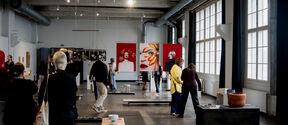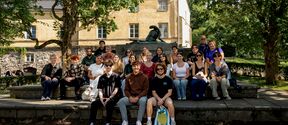Dragons out! Kari Kakkonen employs fantasy to lead children into the world of software testing

What do you do for a living and why?
I am a consultant, trainer, and author in software testing. My work also has broader links with matters related to information technology, such as agility, DevOps, and artificial intelligence. My typical angle for all these matters is training and coaching.
In addition to software testing, I have constantly had a sales and management angle in play. I have headed various teams along the way, and I currently direct the training business at Knowit.
Along the way my desire to affect the status of software testing in the world of information technology has grown. In 2002 I was involved in setting up the Finnish Association of Software Testing (TestausOSY) and the Finnish Software Testing Board (FiSTB), which is a founding member of the International Software Testing Qualifications Board (ISTQB) which was set up in 2002. These volunteer efforts / positions of trust rapidly expanded to the international level, and I spent the past six years on the executive team of this testing organisation, which is the biggest in the world. Now I have moved to the Board of Directors of another testing organisation, TMMi, which focuses on improving testing processes, and is itself in close cooperation with ISTQB.
Finally, I felt that it was important to pass on the software testing message to children as well. To that end, I chose to write the Dragons Out! book. Writing has always been an enjoyable activity for me, and it is also a way to reach many people that is very easily scalable. It is around this need that I founded a company by the same name - Dragons Out Oy.
How did you become both a software tester and a children's author?
When I studied industrial management at HUT in the 1990s, software testing was only mentioned in one chapter, the last chapter of a textbook, and students were advised to read it on their own because there was not enough time to handle it in the course. Fortunately, the situation has improved since then, and at Aalto it is possible to learn very much about testing as well.
I nevertheless learned the processes and techniques of testing at work in my first job at SEC. I also took a summer course on testing organised by HUT and run by a visiting lecturer when something like that became available. Software testing seemed to be the most interesting part of information technology. It was something that made it possible to affect the good quality of software.
The software testing profession was actually built during my career. It has been wonderful to be part of building an entire profession, even though software testing has existed as long as there has been software.
Writing has always been close to my heart. I have written many different blogs over the years – Testaajan näköalat (“Tester's visions”), my blog in the Tivi publication, might be familiar to many. I have constantly written different kinds of processes and assessment reports for my work, each of which can easily be the size of a small book.
In 2015 I became one of seven authors in the Agile Testing Foundations book project. I enjoyed the project so much that the threshold to writing a book myself disappeared. In addition, I took part in James Whittaker's Storytelling training, which inspired me to find my own voice in the world storytelling.
Storytelling is a more efficient way of presenting things! The point of view for my book came to me as soon as I heard about the book Hello Ruby by Linda Liukas. It was a book on coding for children and as a promoter of the testing field I could immediately see that someone should also write a book about testing for children. And of course, that someone could be me! I was not able to find the time I needed for writing the book until my sabbatical year in 2018.
What have been the high points of your career?
The biggest, most heart-warming recognition is the EuroSTAR Software Testing Excellence Award, that I got recently. It is the greatest European award in the field of software testing (https://conference.eurostarsoftwaretesting.com/awards/) and it is magnificent to join the illustrious group of recipients of that award! The award is linked with my whole career, but the matter was naturally topical right now, after I wrote the ground-breaking work Dragons Out, which tells about testing to a new group of people - children. You can read more about how I felt in my blog: https://www.dragonsout.com/2021/10/european-testing-excellence-award-from.html
I also warmly remember how Knowit's testing business expanded from ten people to hundreds starting in 2005. I was part of the core team when that dazzling growth was happening.
However, the publication of my own book was ultimately the biggest thing. I had put so much creativity and sweat into it that when it finally was published, both by Avain in Finnish and by Austin Macauley in English, my feeling was one of incredulous enthusiasm. Something great and magnificent had been achieved. At the same time the book requires constant additional work: marketing, organising translations, speaking at events, visits to schools. I suspect that the greatest heights are yet to come at later stages on this road.
How do you get children excited about software testing?
Children need to get excited about a new thing, whatever it is. It must be made to seem fascinating and compelling. I deliberately chose a world of fantasy for my book.
If they find a story about a battle between dragons and knights and children having adventures in that world to be interesting, then they might also be inspired by testing and understand, with the help of analogies, what testing, and more broadly, software development, are all about.
Stories need to be enchanting, just like a good book. Consequently, my book can be read purely as a fantasy story, but reading the matters on testing is something that happens on the side, because the explanations have been embedded in the story as test boxes. It is important to keep two parallel story lines, fantasy and learning the facts of testing, intact.
How did studying at Aalto prepare you for work, and for your present role?
Aalto has many good courses in both industrial management and information technology. My advanced studies were especially useful in providing the skills I needed in my work. There was also a good exchange programme. I was able to spend a year at the University of Wisconsin-Madison in the United States as part of my studies. These software testing skills were hardly taught at all, but I got a pretty good background in other computer skills. I also learned plenty of management skills.
I found active student organisations to be a good addition. I was especially active in AIESEC where I feel that I learned the sales and organising skills that I have often needed in my career. An active role in AIESEC also set a spark to try to improve the world, and when I started work, I found another channel for that spark in software testing organisations.
What advice would you give yourself if you were a student now?
Remember to network, maintain a balance between the moving ahead with your studies and participating in the activities of student organisations. In fact, I did that, and I would not go out and change anything, but I would remind myself to do something more than just attending lectures and reading for exams. So, think horizontally!
What do you expect from the future?
More interesting challenges in software testing, great success for the Dragons Out book project, sequels to the book, and a learning game based on the book. I have many different possibilities in mind, places to go to guide children toward software testing.
Soon I will need to decide on the next steps, based on feedback from around the world and what I have learned from it. Listening to the customer is the key. In any case I will certainly continue balancing with many things: gainful employment, the book project, volunteer work. And of course, there is family life with a wonderful wife, son, and a puppy. More hiking and camping in the near future – that is obvious!
Read more news

The year in Review: What happened in 2025?
A recap of the milestones of the Master in Contemporary Design in 2025
“This hands-on approach is the absolute best way to learn” – Loyola University and Aalto University partnered for the sixth time
Isabel Towghi shares her experience from Aalto University Summer School.
Two Unite! Seed Fund projects involving Aalto secure top EU funding
Two prestigious EU grants have been awarded to projects that were initially supported with Unite! Seed Funding. Both projects involve Aalto.






